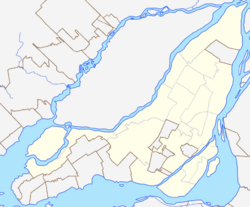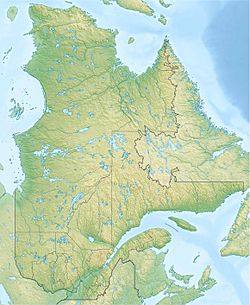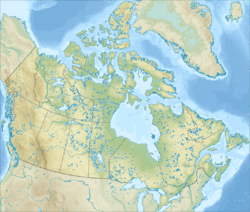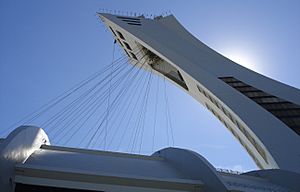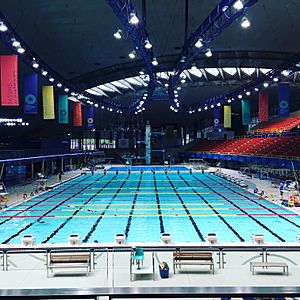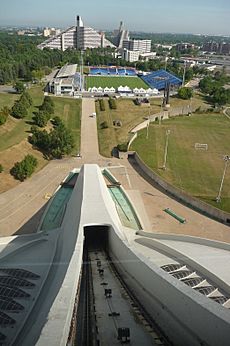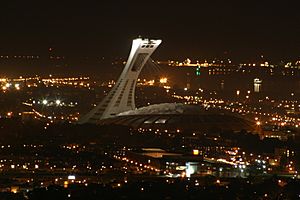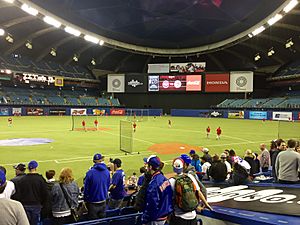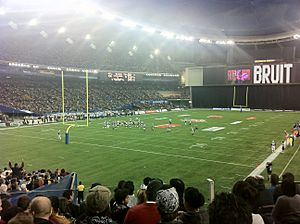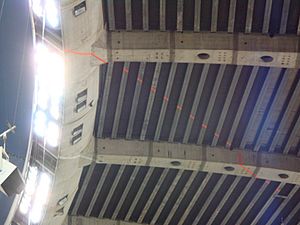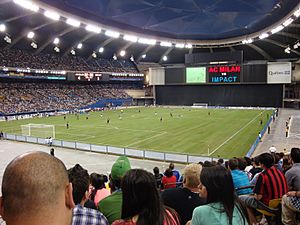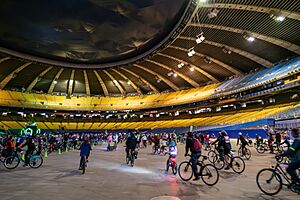Olympic Stadium (Montreal) facts for kids
| Stade Olympique | |
|
The Big O
The Big Owe |
|
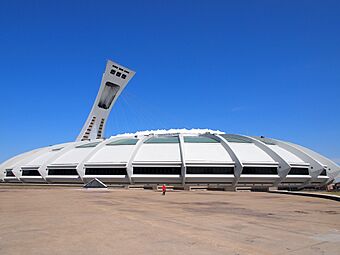 |
|
| Address | 4545 Pierre-de-Coubertin Avenue |
|---|---|
| Location | Montreal, Quebec, Canada |
| Coordinates | 45°33′29″N 73°33′07″W / 45.558°N 73.552°W |
| Public transit | |
| Owner | Régie des Installations Olympiques (Government of Quebec) |
| Capacity | Permanent capacity: 56,040 (1992–present) 1976 Summer Olympics: 73,000 (1976–1992) Baseball: 49,757 (1992–present) Soccer: 61,004 Football: 66,308 |
| Record attendance | 78,322 (Pink Floyd, July 6, 1977) |
| Field size | Foul Lines: 99 metres (325 ft) (1977), 101 metres (330 ft) (1981), 99 metres (325 ft) (1983) Power Alleys: 114 metres (375 ft) Centre Field: 123 metres (404 ft) (1977), 123 metres (405 ft) (1979), 123 metres (404 ft) (1980), 122 metres (400 ft) (1981), 123 metres (404 ft) (1983) Backstop: 19 metres (62 ft) (1977), 20 metres (65 ft) (1983), 16 metres (53 ft) (1989) |
| Surface | Grass (1976 and June 2, 2010) AstroTurf (1977–2001, 2005–06) Defargo Astrograss (2002–03) FieldTurf (2003–2005) Team Pro EF RD (2007–2014) Xtreme Turf by Act Global (2014–2022) FIFA Quality Pro (2023–) |
| Construction | |
| Broke ground | April 28, 1973 |
| Opened | July 17, 1976 April 15, 1977 (baseball) |
| Construction cost | C$ 770 million C$ 5.2 billion (2017 – including additional costs, interest and repairs for the entire Olympic Park) |
| Architect | Roger Taillibert |
| Tenants | |
| Montreal Expos (MLB) (1977–2004) Montreal Alouettes/Concordes (CFL) (1976–86, 1996–97, part-time 1998–2013) Montreal Manic (NASL) (1981–83) Montreal Machine (WLAF) (1991–92) CF Montréal (MLS) (2012–present, select games) |
|
| Website | |
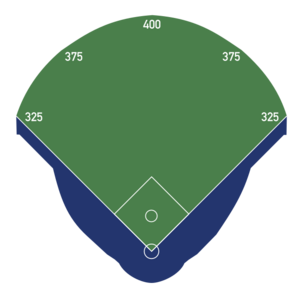 |
|
The Olympic Stadium (also known as Stade olympique in French) is a huge building in Montreal, Canada. It's part of Olympic Park in the city's Hochelaga-Maisonneuve area. This stadium was built in the mid-1970s to be the main place for the 1976 Summer Olympics.
People often call it "The Big O" because of its name and its round, doughnut-like roof. It also got the nickname "The Big Owe" because it cost a lot of money to build and run the 1976 Olympics.
The stadium is one of the biggest in Canada. After the Olympics, it became home to Montreal's professional baseball and football teams. The Montreal Expos baseball team played here until 2004. The Montreal Alouettes football team also played many games here.
Today, the stadium is used for many different events. These include concerts, trade shows, and some games for CF Montréal, a professional soccer team. They play here when many tickets are sold or when the weather is too cold for their outdoor stadium.
The stadium has not had a main team since the Expos left in 2004. Because of its many building and money problems over the years, some people call it a "white elephant". This means it's a large, expensive thing that is hard to get rid of but not very useful.
A tall, leaning tower, called the Montreal Tower, is part of the stadium's north side. It's 165 metres (541 ft) high and is the tallest leaning structure in the world. The stadium and Olympic Park are next to Maisonneuve Park, which has the Montreal Botanical Garden.
Contents
History of the Olympic Stadium
How the Stadium Was Planned
Back in 1963, Montreal's Mayor, Jean Drapeau, wanted to build a covered stadium. He thought it was important to have a roof for a Major League Baseball team, especially because of Montreal's cold weather. In 1967, when Montreal was getting a baseball team, Mayor Drapeau promised a covered stadium by 1971.
The stadium was designed by a French architect named Roger Taillibert. He planned a special building with a roof that could open and close. This roof would be held up by cables from a huge 165-metre (541 ft) tower. This tower is the tallest leaning structure in the world.
The Olympic swimming pool is located under this tower. There was also an Olympic velodrome (a track for bicycle racing) nearby. This velodrome is now the Montreal Biodome, a popular indoor nature museum. The stadium hosted the opening and closing ceremonies, athletics, football, and equestrian events during the 1976 Summer Olympics.
The building's design is seen as a great example of modern architecture. Taillibert was inspired by plants and animals, giving the stadium a unique look.
Building the Stadium
The stadium was supposed to be finished in 1972, but construction faced many delays. There were strikes by workers and problems with the stadium's complex design. The architect, Taillibert, wanted to stick to his original plans, even when costs for materials went up.
In 1974, the government got tired of the delays and high costs, so they removed Taillibert from the project. Also, Montreal's cold winters slowed down work for a third of the year. Because of these issues, the stadium and its tower were not fully ready when the 1976 Olympic Games began.
The materials for the roof sat in a warehouse until 1982. The tower and roof were finally finished in 1987, more than a decade late. The 5,500 m2 (59,000 sq ft) Kevlar roof could open and close, but only when winds were not too strong. It was only used 88 times before it was removed.
The Observatory Tower
When work on the stadium's tower started again after the 1976 Olympics, an observatory was added. You can reach it by an inclined elevator that travels 266 metres (873 ft) up the curved tower. The elevator opened in 1987.
The elevator ride takes less than two minutes and offers amazing views. From the top, you can see the Olympic Village, the Biodome, the Botanical Gardens, and downtown Montreal.
How the Stadium Was Paid For
In 1970, people thought the stadium would cost about C$134 million. But strikes and delays made the costs much higher. By the time the stadium opened, it had cost C$1.1 billion.
To help pay for it, the Quebec government started a special tobacco tax in 1976. It took over 30 years, but the stadium's costs were finally paid off in November 2006.
The total cost, including repairs and interest, reached C$1.61 billion. This made it one of the most expensive stadiums ever built at that time. Because of its high cost, people often called it "The Big Owe."
Ongoing Challenges
Even after the tower and retractable roof were finished, problems continued. In 1986, a large piece of the tower fell onto the field before a baseball game. Luckily, no one was hurt.
The Kevlar roof, installed in 1987, often ripped, letting rain leak inside. In 1991, during renovations, a concrete slab fell onto an outside walkway. Again, no one was injured, but the baseball team had to play their last games of the season in other cities.
For safety, the Kevlar roof was kept closed all the time in 1992. It was removed in 1998, making the stadium open-air. Later in 1998, a new, non-opening blue roof was put on.
In 1999, a part of this new roof collapsed due to ice and snow. This caused events to be cancelled. To fix this, a system was installed to circulate heated water under the roof to melt snow. Even with these fixes, the stadium floor was closed from December to March for many years.
The stadium's condition got worse in the early 2000s. The concrete was chipped and stained.
Plans for a New Roof
In 2009, a report said the roof was unsafe during heavy rain or snow. It ripped many times a year. The fire department even warned that the stadium might have to close without a new roof.
In 2015, a new, modern scoreboard was installed. In 2017, the Quebec government approved a new roof project, estimated to cost $250 million. This new roof was planned to be removable, like the original idea. However, the removable part of the roof was later removed from the plans.
In February 2024, the estimated cost for the new roof increased to $870 million. It is expected to take four years to build and last for 50 years. Demolishing the stadium would be very expensive because of its special concrete structure and the Metro lines running underneath it.
What the Stadium is Used For Now
Football Games
The Montreal Alouettes, a Canadian Football League team, started playing at the stadium in 1976. They played there until 1986. The team came back in 1996 and 1997, then moved to a smaller stadium. However, they still used Olympic Stadium for some big games until 2012.
The stadium holds the record for the largest crowd at a Grey Cup game (the CFL championship) in 1977. It also holds records for many of the largest crowds in CFL history.
In the early 1990s, the stadium was home to the Montreal Machine of the World League of American Football.
Baseball Games
In 1977, the stadium became the home of the Montreal Expos baseball team. They played 81 home games each season until 2003. In their last two seasons (2003 and 2004), they played some games in Puerto Rico. The Expos team moved to Washington, D.C., in 2005 and became the Washington Nationals.
The first baseball game at Olympic Stadium was on April 15, 1977. The Expos lost to the Philadelphia Phillies in front of a large crowd. In 1982, the Major League Baseball All-Star Game was held here, setting a stadium record for baseball attendance. The Expos played their last game in Montreal on September 29, 2004.
The stadium had some challenges for baseball. The seats were further back than in stadiums built just for baseball. Also, the upper deck seats were very high and far from the field.
The Expos were not involved in the stadium's design. But they tried hard to make it a fun place for baseball fans. Before the 1991 season, the stadium was updated for baseball. The running track was removed, home plate was moved closer, and new seats were added.
The playing field was a thin artificial turf over concrete, which was hard on players' knees. Before the roof was finished, players sometimes had to deal with ice on the field.
After the Expos left, the Toronto Blue Jays played spring training games here against other MLB teams from 2014 to 2019. These games drew huge crowds.
Longest Home Runs
Willie Stargell hit the longest home run at Olympic Stadium on May 20, 1978. It went into the second deck in right field, an estimated 535 feet. A yellow seat marked where it landed, but it has since moved to the Canadian Baseball Hall of Fame.
Darryl Strawberry hit a ball 525 feet in 1988 that bounced off a speaker. Henry Rodríguez also hit a ball an estimated 525 feet in 1997. Vladimir Guerrero hit the longest home run to left field in 2003, which hit an advertising sign.
Soccer Matches
The stadium was home to the Montreal Manic soccer team from 1981 to 1983. In 2007, it hosted several games for the 2007 FIFA U-20 World Cup, drawing very large crowds.
The Montreal Impact (now CF Montréal) played important international soccer games here. In 2009, a game against Club Santos Laguna drew over 55,000 fans. In 2010, a friendly match against A.C. Milan had 47,861 people watching.
In 2012, a record crowd of 58,912 watched the current Montreal Impact play their first home game in Major League Soccer. This record was broken later that year with 60,860 fans.
The stadium hosted the final of the 2014 FIFA U-20 Women's World Cup. In 2015, a record 61,004 people watched the CONCACAF Champions League final here. Olympic Stadium also hosted several matches for the 2015 FIFA Women's World Cup, including a semi-final game between the United States and Germany.
Other Events
The stadium has hosted many other events. In 1977, the band Emerson, Lake and Palmer filmed a performance here. In 1978, it hosted the World Junior Speed Skating Championships.
In 1980, Roberto Durán won a boxing championship here against Sugar Ray Leonard. The Drum Corps International World Championship finals were held here in 1981 and 1982.
In 1984, Pope John Paul II met with about 55,000 young people at the stadium. In 2010, a special mass was held to celebrate Brother André becoming a saint, with over 30,000 people attending.
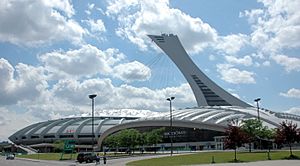
In 2017, the stadium was the site of the 2017 Artistic Gymnastics World Championships. In 2021, during the COVID-19 pandemic, Olympic Stadium became a large vaccination site for the public.
1992 Concert Incident
On August 8, 1992, the bands Metallica and Guns N' Roses played a concert at Olympic Stadium. During Metallica's performance, the lead singer, James Hetfield, was accidentally burned by fireworks. This caused Metallica to stop their show early.
After a long delay, Guns N' Roses played a shorter set. After their performance, some fans became unruly and caused damage inside and outside the stadium. The stadium management later banned Guns N' Roses from playing there again.
Metallica returned to Olympic Stadium in August 2023 for the first time since that event.
Attendance Records
Pink Floyd holds the record for the largest paid crowd at Olympic Stadium, with 78,322 people on July 6, 1977. The second-largest crowd was 73,898 for Emerson, Lake & Palmer in August 1977.
Getting There
The stadium is directly connected to the Pie-IX metro station on the Green Line of the Montreal Metro. The Viau metro station is also very close by.
Interesting Facts
- The stadium cost $770 million to build. By 2006, with repairs and interest, the total cost was $1.47 billion. It took 30 years to pay off, which is why it was nicknamed "The Big Owe."
- The roof is only 52 m (170.6 ft) above the field. Because of this, many baseballs hit the roof. Orange lines were painted on the roof to show if a ball was fair or foul.
- The Olympic Stadium holds the record for the most people at a soccer game in Canada. In the 1976 Summer Olympics soccer final, 71,617 people watched East Germany beat Poland.
- A yellow seat in the stadium used to mark a 535-foot (163 m) home run hit by Willie Stargell. This seat is now at the Canadian Baseball Hall of Fame.
- For the first time since the 1976 Olympics, natural grass was put in the stadium for a soccer match in 2010.
- The stadium has a very powerful public address system, with 101,600 watts.
- The main area of the stadium is the largest in Quebec, covering 43,504 m2 (468,270 sq ft).
- Tony Gwynn got his 3,000th career hit in baseball at Olympic Stadium in 1999.
Commemorations
Canada Post created special stamps for the 1976 Olympics. One of these stamps showed the Olympic Stadium and Velodrome.
Images for kids
See also
 In Spanish: Estadio Olímpico de Montreal para niños
In Spanish: Estadio Olímpico de Montreal para niños


